Can the warming be stopped?
(April 2025)
(April 2025)
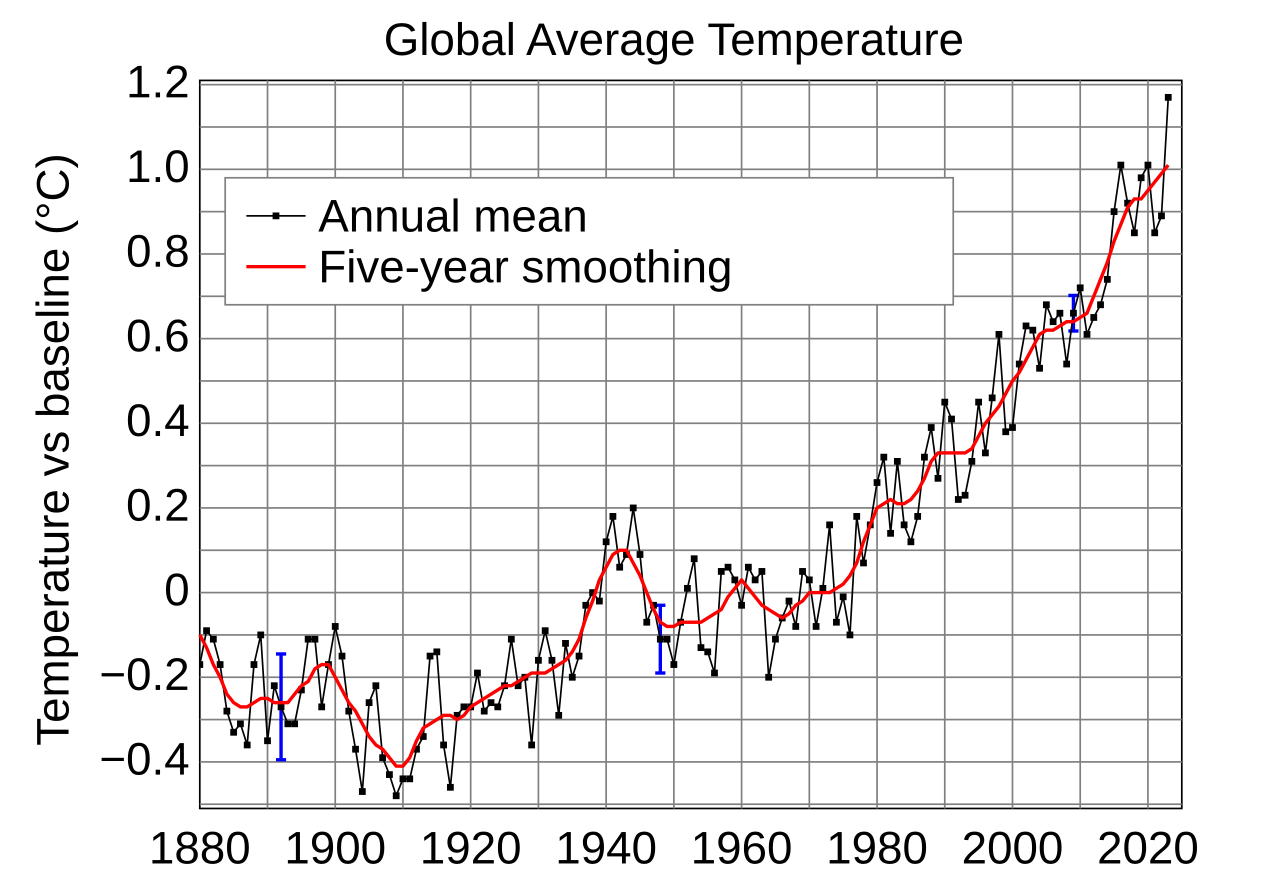
Global mean temperature, can be approximated by a line from 1970
(https://hu.wikipedia.org/wiki/Glob%C3%A1lis_felmeleged%C3%A9s)
Paris Agreement (2015) target to keep the global average temperature increase below 2°C compared to pre-industrial levels. After a rise of one and a half degrees, the process is considered irreversible. There are no consequences if the Agreement is not respected (https://hu.wikipedia.org/wiki/P%C3%A1rizsi_%C3%A9ghajlatv%C3%A9delmi_egyezm%C3%A9ny). In 2025 the value of increment is 1. 3°C. Because of the unequal temperature distribution, it is better to talk about a warming of a smaller area, e.g. Europe, where it is about 2. 4°C. There has been warm in the tropics up to now (it is even warmer now, people are moving away), so it is useful to assess temperature changes in the north or south territories separately. The rapid warming started in the 1970s. The method of research was the data mining on the internet.
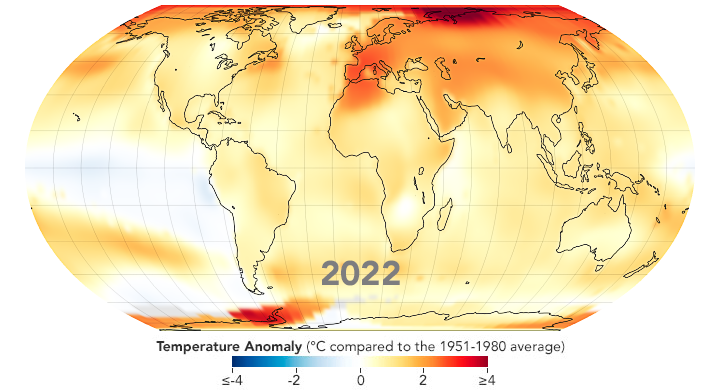
The relative temperature is distributed, in Europe 2.4 °C
The most obvious signs of warming are forest fires, droughts, floods, landslides, and the human and economic damage caused by heat waves. Part of the damage caused by the expected power blackouts could be used to cover the cost of preventive steps. Anticyclones cause dry heat, and warmer atmospheres store more energy and moisture, which intensifies weather extremes, such as thunderstorms. The Mediterranean is 1.2°C warmer than it was in the mid-1900s, with surface temperatures of 26.5°C already conducive to tornadoes.
The frequency of wildfires is highly drought-dependent, and we examined trends in the number and area of wildfires in California because they are well documented: every 10 years until the 2000s, the number and area of fires were about constant, but have increased many-fold in the last 10 years. Relative increases elsewhere will be similar to California, as well, if vegetation dries out (https://www.fire.ca.gov/our-impact/statistics?form=MG0AV3, https://oehha.ca.gov/sites/default/files/media/downloads/climate-change/document/04wildfires.pdf).
Repeated fires have been a natural part of forest fields since geological antiquity: in evergreen Mediterranean shrublands, savannas, temperate grasslands, and northern pine forests.They cause problems when human settlements get in the way of a fire. In natural regeneration, also known as wildfire, the root level is not usually damaged and, although there is a lot of destruction and heat, the ash acts as a fertiliser. Centuries of observation have shown that fires occur almost exclusively in autumns following dry summers, and only appear to burn vegetation out completely. After the winter rains, life quickly resumes in the burnt landscapes in spring.
The frequency of wildfires is highly drought-dependent, and we examined trends in the number and area of wildfires in California because they are well documented: every 10 years until the 2000s, the number and area of fires were about constant, but have increased many-fold in the last 10 years. Relative increases elsewhere will be similar to California, as well, if vegetation dries out (https://www.fire.ca.gov/our-impact/statistics?form=MG0AV3, https://oehha.ca.gov/sites/default/files/media/downloads/climate-change/document/04wildfires.pdf).
Repeated fires have been a natural part of forest fields since geological antiquity: in evergreen Mediterranean shrublands, savannas, temperate grasslands, and northern pine forests.They cause problems when human settlements get in the way of a fire. In natural regeneration, also known as wildfire, the root level is not usually damaged and, although there is a lot of destruction and heat, the ash acts as a fertiliser. Centuries of observation have shown that fires occur almost exclusively in autumns following dry summers, and only appear to burn vegetation out completely. After the winter rains, life quickly resumes in the burnt landscapes in spring.
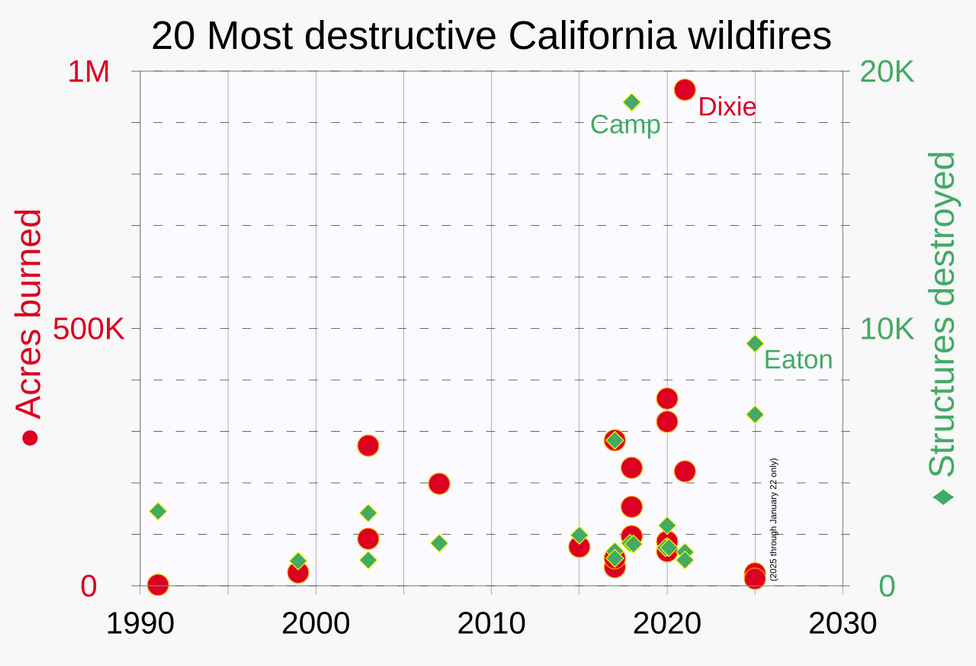
The most destructive wildfires in California
(https://en.wikipedia.org/wiki/List_of_California_wildfires)
(https://en.wikipedia.org/wiki/List_of_California_wildfires)
In California, two fire seasons are distinguished: one lasting from June to September, caused by warm, dry weather, and the fires in the interior of the dry land, in the higher forests, caused by drought. The second season lasts from October to April and is fuelled by the Santa Ana winds. These fires spread three times faster and ignite near urban regions; in the 1990s, they caused 80 percent of the economic damage associated with wildfires. Santa Ana winds not only dry out vegetation, but also spread embers (https://en.wikipedia.org/wiki/List_of_California_wildfires), igniting more fires. According to California firefighters, fires have changed because large areas of vegetation are dry (often shrubs, bushes, brush), fire columns are more common, which also lift embers, burning plants and branches over walls, rivers, wide roads: " fires jump". Before 1800, when the area was much more forested and resilient, 4.4 to 11.9 million acres per year (1 acre = 4 046.85642 m2, i.e. an area of 1.8-4.8 million hectares) of forest and shrubland burned. California's total area is 99,813,760, or roughly 100 million acres.
Since 2000, the annual area burned has ranged from 0.09% to 1.59% of California's total area. In the 2020 wildfire season alone, more than 8,100 fires contributed to the burning of nearly 4.5 million acres of land. The number of fires recorded in the last 10 years is at a six times higher rate than the number of fires recorded in the previous decade.
Can warming be stopped?
In 2025, it is no longer a question of prevention but of slowing down, perhaps even stopping the warming. We have three devices, the first is passive: reducing emissions of harmful gases, but more important are to remove the gases already emitted from the atmosphere and, whatever the cause of warming, to change the climate. The latter two are active methods, and when global warming reaches 1.5°C, and 2.6°C in Europe, we will switch to active methods, such as injecting carbon dioxide into certain basalt rocks, because basalt absorbs carbon dioxide forever, and modification of the climate. Just don't be too late, because active methods are experimental ones.
In 2025, it is no longer a question of prevention but of slowing down, perhaps even stopping the warming. We have three devices, the first is passive: reducing emissions of harmful gases, but more important are to remove the gases already emitted from the atmosphere and, whatever the cause of warming, to change the climate. The latter two are active methods, and when global warming reaches 1.5°C, and 2.6°C in Europe, we will switch to active methods, such as injecting carbon dioxide into certain basalt rocks, because basalt absorbs carbon dioxide forever, and modification of the climate. Just don't be too late, because active methods are experimental ones.
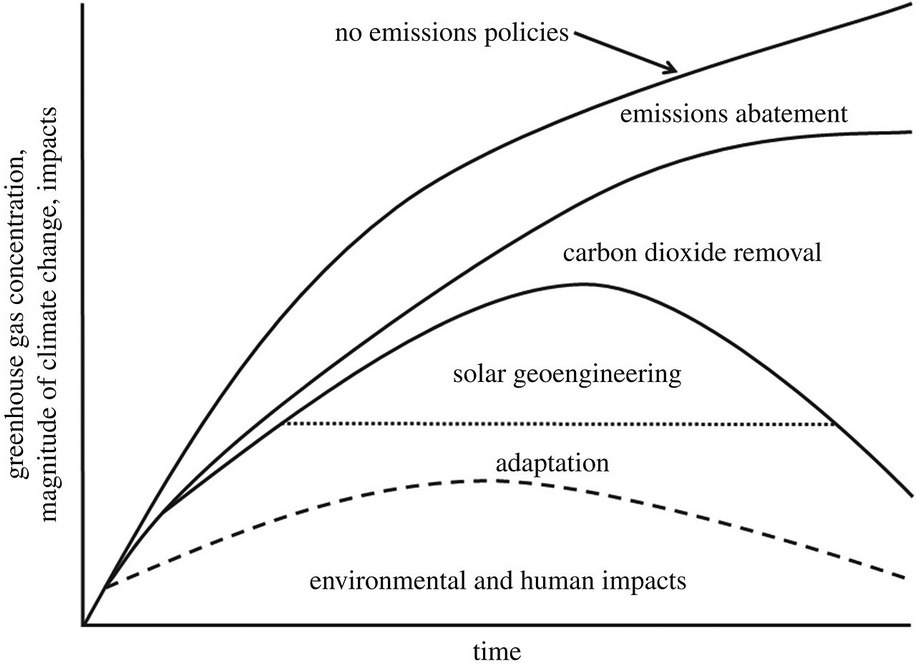
Impact of the interventions
The increments of the temperature increase will follow a logistic curve (https://en.wikipedia.org/wiki/Logistic_function), as natural processes do in general. At least we hope it will behave like other processes in nature. The decreasing slope of the phase is determined by the rate of climate change. Many natural processes proceed by accelerating in time from an initial value and then decelerating as they approach the final state, The centre of the curve is called the inflection point, where the straight tangent touches and intersects the curve from both the outside and the inside.
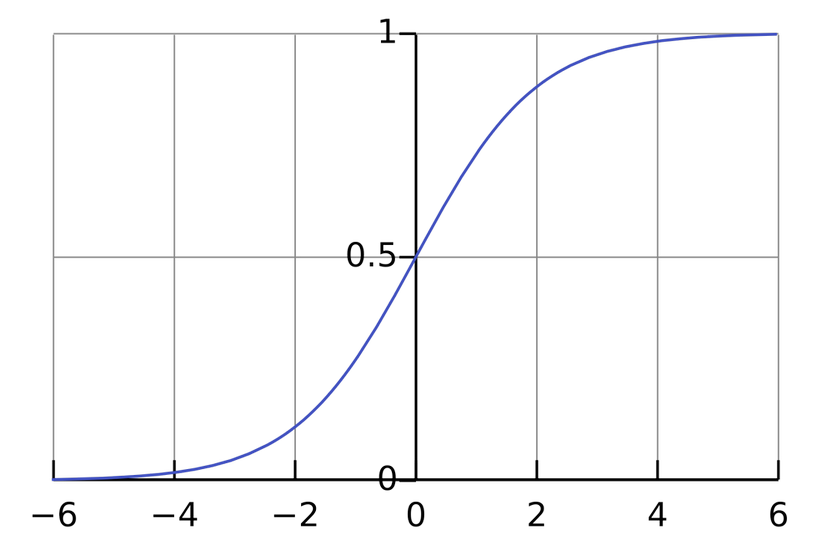
Logistic curve with inflection point above the origin, at 0.5
(where the slope is fastest, https://en.wikipedia.org/wiki/Logistic_function)
(where the slope is fastest, https://en.wikipedia.org/wiki/Logistic_function)
The equation of the logistic curve is very simple: 1/( 1 + exp (-kt) ), where t = 2,4,6,... k is a fitting parameter, there are several parametric versions of the curve. The area under the curve is also very easy to calculate as a function of kt: ln ( 1 + exp(kt) ). The difficult issue is the estimation of the maximum and k, the calculation of the inflection point, i.e. the scaling. The goal of climate modification is to reach the inflection point as soon as possible.
Climate modification is possible by increasing the Earth's solar reflectance, the albedo. Although some scientists argue against climate change, the unpredictability of climate change is their main argument. Opponents of climate change should be compared to opponents of vaccination*. When there is a big problem, a binding agreement, law or regulation will make protection mandatory. Increasing the albedo in small areas is a relatively cheap procedure, on the surface, e.g. in Norway glaciers are protected with artificial snow, in Switzerland glacial lakes are covered with solar panels.
The UK has earmarked more than $66 million (24 billion forints) to inject aerosol particles into the stratosphere to reflect some of the light the sun shines on the Earth. Aerosol is made up of small solid particles or liquid droplets dispersed in the air and can be natural or artificial. Examples of natural aerosols are fog, clouds, or fine, fine-grained dust suspended in the air. In an albedo modification experiment, aircraft release sulphate particles or metallic salts into the stratosphere, the lower layers of the atmosphere, which reflect the sun's rays and prevent them from reaching the earth's surface. Methods include 'sea cloud brightening', where sea salt is sprayed into the atmosphere to make clouds whiter and reflect more solar energy. Another strategy is to break up thin clouds of flakes (cirrus) that act as heat-retaining blankets.
Climate modification is possible by increasing the Earth's solar reflectance, the albedo. Although some scientists argue against climate change, the unpredictability of climate change is their main argument. Opponents of climate change should be compared to opponents of vaccination*. When there is a big problem, a binding agreement, law or regulation will make protection mandatory. Increasing the albedo in small areas is a relatively cheap procedure, on the surface, e.g. in Norway glaciers are protected with artificial snow, in Switzerland glacial lakes are covered with solar panels.
The UK has earmarked more than $66 million (24 billion forints) to inject aerosol particles into the stratosphere to reflect some of the light the sun shines on the Earth. Aerosol is made up of small solid particles or liquid droplets dispersed in the air and can be natural or artificial. Examples of natural aerosols are fog, clouds, or fine, fine-grained dust suspended in the air. In an albedo modification experiment, aircraft release sulphate particles or metallic salts into the stratosphere, the lower layers of the atmosphere, which reflect the sun's rays and prevent them from reaching the earth's surface. Methods include 'sea cloud brightening', where sea salt is sprayed into the atmosphere to make clouds whiter and reflect more solar energy. Another strategy is to break up thin clouds of flakes (cirrus) that act as heat-retaining blankets.
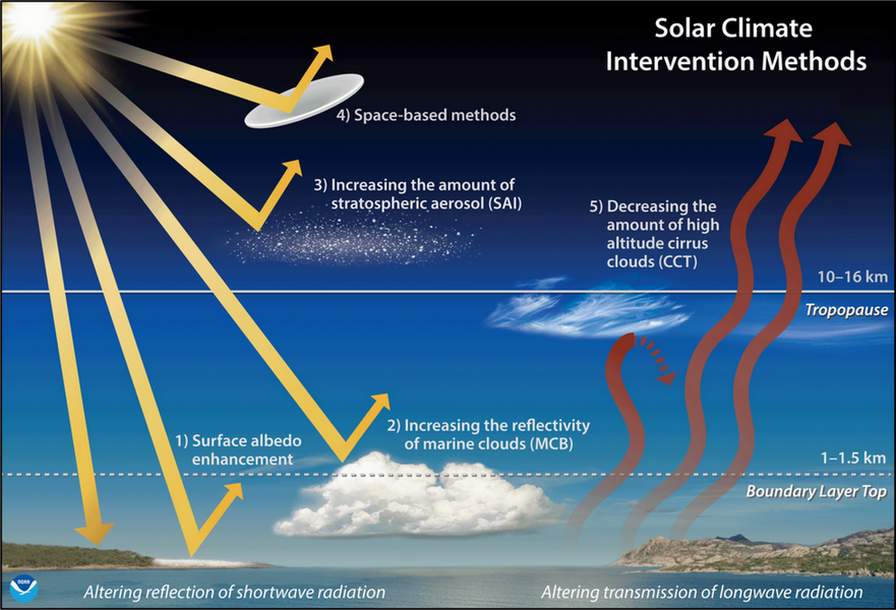
Of the possible methods (https://en.wikipedia.org/wiki/Solar_radiation_modification), stratospheric aerosol injection has been the most studied, followed by sea cloud brightening and bleaching**. If we could increase the reflectivity of clouds by just three per cent, we would be able to completely offset the warming caused by carbon dioxide entering the atmosphere. The methods are technically feasible and have relatively low direct financial costs, and countries could be able to apply them independently. At present, the US, China and Arab countries are engaged in albedo enhancement and its use is not yet regulated.
*
The purpose of administering a vaccine (vaccination) is to increase the body's resistance to certain diseases, artificially inducing immunity. After the administration of vaccines (artificial immunisation), the body develops immunity to the pathogen. If enough people in a community are vaccinated against a particular disease (a certain level of vaccination coverage is reached), a population level of immunity to that disease is established (herd immunity). Some vaccinations are compulsory, others are optional.
The purpose of administering a vaccine (vaccination) is to increase the body's resistance to certain diseases, artificially inducing immunity. After the administration of vaccines (artificial immunisation), the body develops immunity to the pathogen. If enough people in a community are vaccinated against a particular disease (a certain level of vaccination coverage is reached), a population level of immunity to that disease is established (herd immunity). Some vaccinations are compulsory, others are optional.
**The idea of cloud brightening dates back to 1990, when a physicist called John Latham published a paper in Nature entitled "Controlling global warming?" and suggested that tiny particles should be injected into clouds. Latham came up with the idea after his son asked him on a walk why the tops of clouds were brighter than the bottoms, and he explained that they were actually mirrors that reflected the sun's rays. Latham also suggested the idea of creating an unmanned fleet of a thousand sailboats that would spray tiny droplets of seawater into the air around the world's oceans, reflecting the sun's rays. Many tiny drops reflect light better than a few large ones by injecting aeorosol into the clouds. If we could increase the reflectivity of clouds by just three per cent, we would be able to completely offset the warming caused by carbon dioxide in the atmosphere. The size of aerosols for cloud brightening has to be chosen very carefully: if they are too small they have no effect, if they are too large they have the opposite effect, with the ideal particle being around seven hundredths of the thickness of a human hair. A device resembling a snow cannon can use a series of nozzles to blow air from an aircraft at a pressure high enough to atomise salt crystals just the right size high up in the air.
